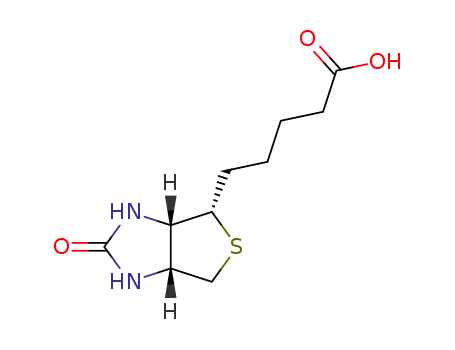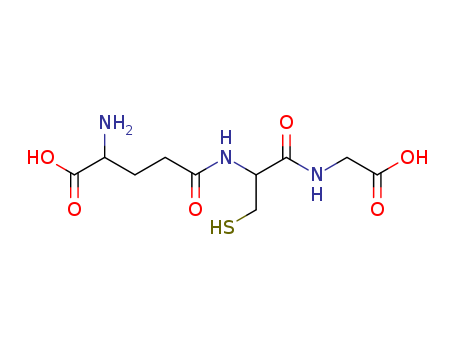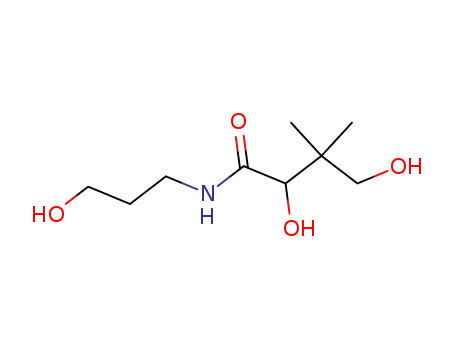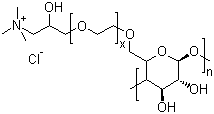
58-85-5
- Product Name:Biotin
- Molecular Formula:C10H16N2O3S
- Purity:99%
- Molecular Weight:244.315
Product Details
pd_meltingpoint:231-233 °C(lit.)
Appearance:white powder
Factory sells Biotin 58-85-5 with sufficient production capacity
- Molecular Formula:C10H16N2O3S
- Molecular Weight:244.315
- Appearance/Colour:white powder
- Vapor Pressure:1.19E-14mmHg at 25°C
- Melting Point:231-233 °C(lit.)
- Refractive Index:90.5 ° (C=2, 0.1mol/L NaOH)
- Boiling Point:573.6 °C at 760 mmHg
- PKA:4.74±0.10(Predicted)
- Flash Point:300.7 °C
- PSA:103.73000
- Density:1.267 g/cm3
- LogP:1.45440
D-Biotin(Cas 58-85-5) Usage
|
Roles and Functions |
Coenzyme for Carboxylases: Biotin is an essential cofactor for biotin-dependent enzymes, including carboxylases, decarboxylases, and transcarboxylases. |
|
Structure |
Chemical Structure: Biotin consists of a tetrahydroimidizalone ring fused with an organosulfur-containing tetrahydrothiophane ring that bears a valeric acid substituent. |
|
Enzymatic Attachment |
Attachment Process: The attachment of biotin to enzyme proteins is mediated by the formation of an amide linkage between the biotin carboxyl group and the 蔚-amino group of a specific lysine residue. |
|
Health Implications |
Deficiency: Severe biotin deficiency has been linked to birth defects, misdiagnosis of multiple sclerosis, and impaired immune function. |
|
Physicochemical property |
Biotin is widely distributed in animals and plants, and the natural presence of biotin is mainly in the form of binding with other molecules. The biochemical structure of biotin includes a shuttle chain containing five carbon atoms and two five-membered heterocycles. In vivo the shuttle of the side chain binds with lysine s residue of enzyme protein, playing a role of coenzyme. Biotin may have 8 different isomers, of which only D-biotin has biological activity. Under normal circumstances, biotin is quite stable, only in the strong acid, alkali, formaldehyde and UV treatment will be destroyed. Biotin is the carrier of carboxyl in the carboxylation reaction required large ATP. The carboxyl group is temporarily bound to a nitrogen atom on the bicyclic ring system of biotin, such as in the reaction of pyruvate carboxylase catalyzing the pyruvate carboxylation of oxaloacetate. Figure1: The structural formula of the biotin molecule |
|
Physiological function |
Biotin is necessary for cell growth, the production of fatty acids, and the metabolism of fats and amino acids. It plays a role in the citric acid cycle, which is the process by which biochemical energy is generated during aerobic respiration. Biotin is a coenzyme for carboxylase enzymes, involved in the synthesis of fatty acids, isoleucine, and valine, and in gluconeogenesis. In addition, biotin is widely used throughout the biotechnology industry to conjugate proteins for biochemical assays. We need biotin about 100 to 300 micrograms per day. There is an antibiotic protein that could combine with biotin in the egg white egg. After combining, it cannot be absorbed by the digestive tract; resulting in animal biotin deficiency, at the same time loss of appetite, glossitis, dermatitis dermatitis, hair removal and so on. However, there is no case of biotin deficiency on human, probably because in addition to food sources, intestinal bacteria can also synthesize biotin. Biotin is a coenzyme of a lot of enzymes in the human body. It participates in the metabolism of aliphatic acid, carbohydrate, vitamin B12, folic acid and pantothenic acid; promoting synthesis of protein and urea, and also promoting excretion. Help fat, glycogen and amino acids for normal synthesis and metabolism in the human body; Promote the normal operation and growth of sweat glands, nerve tissue, bone marrow, male gonads, skin and hair, and reduce eczema, dermatitis symptoms; Prevent white hair and hair loss, contribute to the treatment of baldness; Relieve muscle pain; Promote synthesis and excretion of urea, purine synthesis and oleic acid biosynthesis; For the treatment of atherosclerosis, stroke, dyslipidemia, hypertension, coronary heart disease and blood circulation disorders. |
|
Biotin and fat metabolism |
As a coenzyme of phthalocyanine coenzyme A, Biotin is involved in the synthesis of fatty acids, catalyzing the formation of glycine CoA. The reaction is the first step in the synthesis of fatty acids, and then through the cytoplasmic multi-enzyme complex and fatty acid synthase synthesize palmitic acid from the phthalocyanine-CoA. In the prolongation of carbon chain in the fatty acid, the propanedio phthalide-ACP is involved in the reaction as a donor of the dicarbon unit, and the dipropyl phthalide-ACP is derived from the phthalide-CoA. It can be seen that biotin is necessary for the synthesis of fatty acids and the extension of carbon chains in fatty acid. Biotin deficiency can lead to abnormal lipid metabolism, resulting in changes of fatty acid composition in the body. In addition, synthesis of saturated fatty acid decreased, synthesis of triglyeeride increased, and fat in the liver and kidney increased by 2 to 5 times. Biotin-deficient diets increase the rate of desiccation of palmitic acid in liver tissue by five folds. Palmitic acid increased, at the same time stearic acid reduced. Biotin is also a necessary material for synthesis of long-chain unsaturated fatty acid and fatty acid metabolism. Biotin is also associated with the synthesis of acetylcholine and the metabolism of cholesterol. The lack of biotin reduces the ability of animals to synthesize arachidonic acid from linoleic acid, leading to the accumulation of linoleic acid in the body. |
|
Biotin deficiency |
Biotin deficiency appears to be rare, but some groups may be more susceptible.Biotin supplements are widely available but rarely necessary. A deficiency can lead to: Hair loss A scaly red rash around the eyes, nose, mouth, and genitals Cracks in the corner of the mouth Sore tongue that may be magenta in color Dry eyes Loss of appetite Other symptoms may include: Depression Lethargy and fatigue Hallucinations Insomnia Numbness and tingling in the hands and feet Impaired immune function and increased susceptibility to infections Pregnant women appear to break down biotin more quickly, and this may lead to a marginal deficiency. Symptoms have not been observed, but such a deficiency could lead to developmental problems for the fetus. |
|
Food source |
Liver Peanuts Yeast Whole-wheat bread Cheddar cheese Pork Salmon Sardines Avocado Raspberries Bananas Mushrooms Cauliflower Egg yolk Egg white reduces the effectiveness of biotin from egg yolk in the body because it binds biotin and prevents it from being absorbed. People who consume only egg white for many years without biotin supplementation have a slight risk of not getting enough vitamin B7. Processing food reduces levels of nutrients such as biotin, so raw cauliflower, for example, would provide more biotin than cooked cauliflower. A study published in Advances in Nutrition estimates biotic intake in North America and Western Europe at between 35 to 70 μg per day, or 143 to 287 mmol per day. According to Oregon State University, biotin is not known to cause toxic effects. People with hereditary disorders of biotin metabolism tolerate doses of up to 200,000 mcg per day without any problems. Individuals with no biotin metabolism disorder who took doses of 5,000 mcg per day for 24 months had no adverse effects. However, it is important to speak to a physician or dietitian before making any change to nutritional intake or using supplements. |
|
Toxicity |
Toxicity of biotin seems to be low. Treatment of seborrheic dermatitis with high doses of biotin did not detect abnormal protein metabolism or genetic errors and other metabolic abnormalities. Animal experiments also show that biotin toxicity is low. |
|
Side effect |
Bursts of cystic acne of jaw and chin are the most common side effects of biotin. The specific reason is not very clear. And usually this symptom will disappear by itself after a few weeks. There are also some nutritional supplements who report that acne symptoms can be reduced when the dose is limited to 2500 micrograms or less. In short, the situation experienced by each person is slightly different. Life-threatening biotin is extremely rare. Eosinophilic pleural effusion is the only documented deadly case that causes a woman to die. She ingested a lot of biotin, along with vitamin B5. So far, it is unclear whether her death is caused by biotin, B5, or a mixture of both. Healthy adults are less likely to develop biotin deficiency. This disease is common in excessive consumption of avidin (which can be found in raw eggs), or people with skin or hair disorders (such as phenylketonuria). The symptoms of lacking biotin usually take several years to show. The study found that about 50% of pregnant women had a biotin deficiency problem. They lack a kind of enzyme to tell the body how to use biotin properly, which leads to a decline in metabolic function. Most physicians do not recommend biotin nutrition as a treatment because the trial for rats found that it had a risk of miscarriage and fetal defects. Biotin is often recommended as nourishment for the promotion of hair and nail health. Because of the impact on carbohydrates, it is also often used to control body weight. Biotin supplements are known for their beauty and metabolic effects. The recommended dose ranges from 3 micrograms to 5000 micrograms per day, depending on the specific use. The side effects are relatively rare, and it is relatively easy to control even if the side effects appear, so it is a safe nutritional supplements. |
|
Distinguishing test |
The warm water saturated solution of the sample could cause the drop of the bromine test solution (TS-46) to fade. |
|
Content analysis |
Accurately weighed the sample about 500mg, mixed with 100ml of water, plus phenolphthalein test solution (TS-167) a few drops, with 0.1mol/L sodium hydroxide solution slowly added to the suspension in continuous heating and stirring, until we got pink suspension. 0.1 mol/L sodium hydroxide per ml is equivalent to 24.43 mg biotin (C10Hl6N2O3S). |
|
Applications |
As a feed additive, it is mainly used for poultry and sow feed. Usually the premixed mass fraction is 1%-2%. It is nutritional supplement. According to China GB2760-90 regulations, it could be used as a food industry as a processing aid. It has physiological functions to prevent skin diseases and promote lipid metabolism and so on. It is carboxylase coenzyme, involved in many carboxylation reactions, and is an important coenzyme in the metabolism of sugar, protein and fat. It is used as food fortifier. It is used for infant food with amount of 0.1~0.4mg/kg, in the drinking liquid 0.02~0.08mg/kg. It could be used for labeling proteins, antigens, antibodies, nucleic acids (DNA, RNA) and so on. |
|
Definition |
ChEBI: An organic heterobicyclic compound that consists of 2-oxohexahydro-1H-thieno[3,4-d]imidazole having a valeric acid substituent attached to the tetrahydrothiophene ring. The parent of the class of biotins. |
|
Manufacturing Process |
4-Carbomethoxy-2-(4,5-dihydrothiophen-3(2H)-one)valeric acid methyl ester was prepared from 4,5-dihydrothiophene as it was described in Baker et al., J. Org. Chem., 12, 167 (1947). A solution of 60.0 g (0.182 mole) this ester in 550 ml absolute ethanol was treated with 91.6 g (1.45 moles) of ammonium formate. The reaction mixture refluxed for 5.0 hours. Then it was cooled, concentrated, and partitionated in a separatory funnel between 200 ml dichloromethane and 150 ml water. The aqueous phase was extracted three times with 50 ml portions of dichloromethane. The organic extracts were collected, dried over anhydrous sodium sulfate, and evaporated. 50 g (0.182 mole, 100%) 3-amino-4- carbomethoxy-2,5-dihydro-2-thiophenevaleric acid methyl ester was obtained as a colorless oil. To a solution of 27.3 g (1 mole) of 3-amino-4-carbomethoxy-2,5-dihydro-2- thiophenevaleric acid methyl ester in 250 ml dry methanol was added 4.0 g (0.1 mole) of sodium hydroxide pellets. The reaction mixture was refluxed 4.0 hrs, cooled and concentrated to a volume of 50 ml. The residue was taken up in 80 ml dichloromethane and transfered to a separatory funnel. After the addition of 150 ml of 10% by weight aqueous sodium bicarbonate solution, the aqueous layer was extracted twice with 50 ml portions of dichloromethane. The organic phases were combined, dried over anhydrous sodium sulfate, and evaporated to yield 6.4 g (0.0234 mole) of recovered starting material. The aqueous phase was adjusted to pH 1 with 6 N hydrochloric acid and extracted three times with 75 ml portions of dichloromethane. The organic phases were pooled, dried over anhydrous sodium sulfate, and evaporated to yield 18.3 g (0.071 mole, 71%) of 3- amino-4-carbomethoxy-2,5-dihydro-2-thiophenevaleric acid as a tan solid, upon trituration with pet. ether. The recovered starting material, 6.4 g (0.0234 mole) was dissolved in 70 ml dry methanol and treated with 1.0 g (0.025 mole) sodium hydroxide. The mixture was refluxed 5.0 hrs, cooled concentrated, and taken up in 80 ml dichloromethane. The organic phase was treated in a separatory funnel with 100 ml of 10% by weight aqueous sodium bicarbonate solution. The aqueous phase was extracted twice with 40 ml portions of dichloromethane. The aqueous phase was acidified to pH 1 with 6 N hydrochloric acid and extracted two times with 50 ml portions of dichloromethane. The organic phases were cooled, dried over anhydrous sodium sulfate, and evaporated to dryness to afford an additional 5.3 g (0.021 mole, 21%) of 3-amino-4-carbomethoxy- 2,5-dihydro-2-thiophenevaleric acid; m.p. 98°-102°C. |
|
Therapeutic Function |
Vitamin |
|
General Description |
Pharmaceutical secondary standards for application in quality control, provide pharma laboratories and manufacturers with a convenient and cost-effective alternative to the preparation of in-house working standards.Biotin is a water-soluble vitamin, essential for amino acids and carbohydrates metabolism. It is involved in de novo synthesis of purine nucleotides and plays a role in gene expression and DNA replication. |
|
Biochem/physiol Actions |
Biotin is a vital cofactor for carboxylase enzymes in several metabolic?pathways. It also functions as a coenzyme in the metabolism of fatty acids, isoleucine and valine. Biotin assists the transfer of carbon dioxide and also sustains a steady blood sugar level. Biotin is implicated in gluconeogenesis and citric acid cycle. It?is involved in?keratin?synthesis and hence?is used as?a supplement?for skin, hair and nail growth. Biotin is required for cell growth, production of fatty acids and the metabolism of fats and amino acids. |
|
Safety Profile |
An experimental teratogen. Experimental reproductive effects. When heated to decomposition it emits toxic fumes of NOx and SOx. |
|
Purification Methods |
D-(+)-Biotin crystallises from hot water in fine long needles with a solubility of 22 mg/100mL at 25o. Its solubility in 95% EtOH is 80 mg/100 mL at 25o. Its isoelectric point is at pH 3.5. Store solid and solutions under sterile conditions because it is susceptible to mould growth. [Confalone J Am Chem Soc 97 5936 1975, Wolf et al. J Am Chem Soc 67 2100 1945, Synthesis: Ohuri & Emoto Tetrahedron Lett 2765 1975, Harris et al. J Am Chem Soc 66 1756 1944.] The (+)-methyl ester has m 166-167o (from MeOH/Et2O), [] D 22 +57o (c 1, CHCl3) [du Vigneaud et al. J Biol Chem 140 643, 763 1941]; the (+)-S-oxide has m 200-203o, [] D 20 +130o (c 1.2, 0.1N NaOH) [Melville J Biol Chem 208 495 1954]; the SS-dioxide has m 274-275o(dec, 268-270o), and the SS-dioxide methyl ester has m 239-241o (from MeOH/Et2O) [Hofmann et al. J Biol Chem 141 207, 213 1941]. [Beilstein 27 III/IV 7979.] |
InChI:InChI=1/C10H16N2O3S/c13-8(14)4-2-1-3-7-9-6(5-16-7)11-10(15)12-9/h6-7,9H,1-5H2,(H,13,14)(H2,11,12,15)/p-1/t6-,7-,9+/m0/s1
58-85-5 Relevant articles
SYSTEMS AND METHODS FOR DETECTION OF TARGET ANALYTES USING SELECTIVELY CLEAVABLE BONDS
-
, (2021/09/10)
The invention described herein is direct...
METHOD FOR PRODUCING BIOTIN
-
Paragraph 0067-0083, (2021/02/25)
To provide a production method for obtai...
Solution Dynamics of Hybrid Anderson-Evans Polyoxometalates
Salazar Marcano, David E.,Lentink, Sarah,Moussawi, Mhamad A.,Parac-Vogt, Tatjana N.
supporting information, p. 10215 - 10226 (2021/05/31)
Understanding the stability and speciati...
Selective modification of sulfamidate-containing peptides
Busto, Jesús H.,Jiménez-Osés, Gonzalo,Mazo, Nuria,Navo, Claudio D.,Peregrina, Jesús M.
supporting information, p. 6265 - 6275 (2020/09/07)
Hybrid peptides whose N-terminal residue...
58-85-5 Process route
-
-
C19H24N2O3S

-

- 58-85-5,22879-79-4
biotin
| Conditions | Yield |
|---|---|
|
C19H24N2O3S; With palladium on activated charcoal; hydrogen; In ethanol; at 80 - 85 ℃; for 15h; under 11400.8 - 15201 Torr;
With sodium hydroxide; In water; at 25 - 30 ℃; for 5h; Solvent;
|
86.9% |
-
![5-((3aR,6S,6aS)-1-Benzyl-2-oxo-hexahydro-thieno[3,4-d]imidazol-6-yl)-pentanoic acid](/upload/2024/7/8edcdf98-1042-4667-9f33-d8415b5ab39d.png)
-
5-((3aR,6S,6aS)-1-Benzyl-2-oxo-hexahydro-thieno[3,4-d]imidazol-6-yl)-pentanoic acid

-

- 58-85-5,22879-79-4
biotin
| Conditions | Yield |
|---|---|
|
With hydrogenchloride; sodium dithionite; water; sodium hydroxide; In water; at 55 - 90 ℃; for 0.5h; Reagent/catalyst;
|
95.8% |
58-85-5 Upstream products
-
75-44-5

phosgene
-
22342-46-7

(2S,3S,4R)-cis-5-(3,4-diaminotetrahydro-2-thienyl)valeric acid
-
58-85-5

(+/-)-biotin
-
76335-62-1

5-[(3aS)-1( oder !3)-benzyl-2-oxo-(3ar,6ac)-hexahydro-thieno[3,4-d]imidazol-4t-yl]-valeric acid
58-85-5 Downstream products
-
41994-01-8

biotin-N-(1-propyl)amide
-
67917-55-9

N2-benzyloxycarbonyl-N6-[5-((3aS)-2-oxo-(3ar,6ac)-hexahydro-thieno[3,4-d]imidazol-4t-yl)-pentanoyl]-L-lysine amide
-
62062-42-4

5-((3aS)-2-oxo-1-trifluoroacetyl-(3ar,6ac)-hexahydro-thieno[3,4-d]imidazol-4t-yl)-pentanoic acid 4-nitro-phenyl ester
-
56859-26-8

1-Nitroso-biotin
Relevant Products
-
Glutathione
CAS:70-18-8
-
DL-Panthenol
CAS:16485-10-2
-
Polyquaternium-10
CAS:68610-92-4








